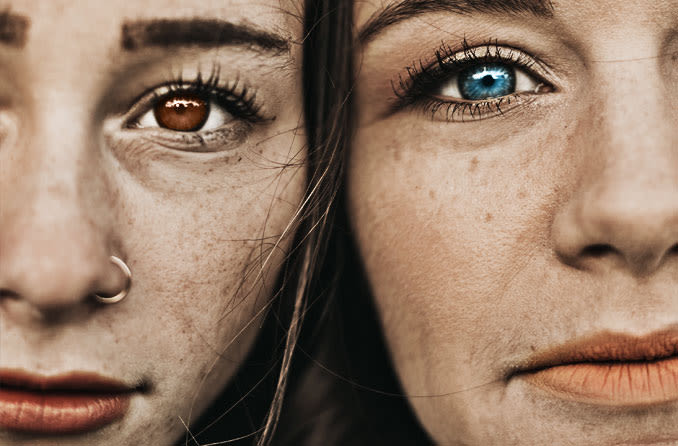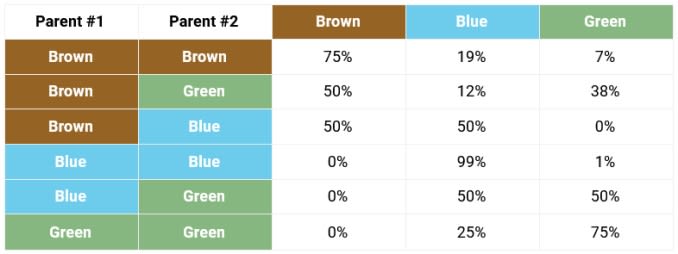Are eye color charts accurate?

Determining natural eye color using genetics
An eye color chart "predicts" a child's eye color based on their parents' eye colors. At least, that's what we used to think.
In the most simplified versions of these charts, brown eyes are considered dominant over both blue and green eyes. Green eyes are often listed as being dominant over blue eyes.

A popular — but outdated — example of an eye color chart.
You've probably seen an eye color chart like the one above. There's a good chance it even included the same (or similar) percentages.
The gist of the chart is generally true. Like it shows, when two parents have the same eye color, their child generally has the highest chance of having that same eye color.
But the details aren't quite as accurate. For example, the chart notes that two blue-eyed parents can't have a brown-eyed baby, but we now know that isn't true.
Unfortunately, there isn't really a convenient, scientifically accurate way to organize eye color odds into chart form.
Human genetics are just too complicated — and too unpredictable.
SEE RELATED: What's the rarest eye color?
The science behind eye color
The color of your eyes relies on the pigment melanin, the same pigment that's in your skin and hair. Eye color depends on how much melanin is in the iris and how it's distributed.
Blue eyes contain much less melanin than brown eyes. Different levels of the pigment create the appearance of blue, brown, and everything in between.
This isn't decided by a single gene. Instead, a bunch of tiny expressions, in many different genes, come together to determine that final eye color. This is why standard eye color charts can be inaccurate.
Some people are even born with two different eye colors, a condition known as heterochromia. Their eyes can each be a different color, or there can be splashes of color on parts of one or both eyes.
Eye color percentages vary based on different populations in different parts of the world. For example, the percentage of dark brown eyes found in Asian and African populations is much higher than in European populations, where blue eyes are relatively common.
And one day, even blue may be a rare eye color. This is because more people now select mates outside their cultural and ethnic groups. So when a brown-eyed person marries someone with blue eyes, offspring are more likely to inherit the more dominant brown eyes — but it's far from a guarantee.
A genetic surprise
While the concepts behind eye color charts are generally true, the genetics of how eye colors are inherited turned out to be much more complicated than once believed.
Currently, it's impossible to determine a child's eye color based on the eye colors of their parents (and grandparents) with 100% certainty. In fact, you can belong to a family with many generations of brown-eyed individuals and still end up with green or blue eyes.
In the meantime, soon-to-be parents should be on the lookout for a potential eye-color surprise.
READ MORE: What makes hazel eyes special
Marilyn Haddrill also contributed to this article.
Page published on Wednesday, February 27, 2019






